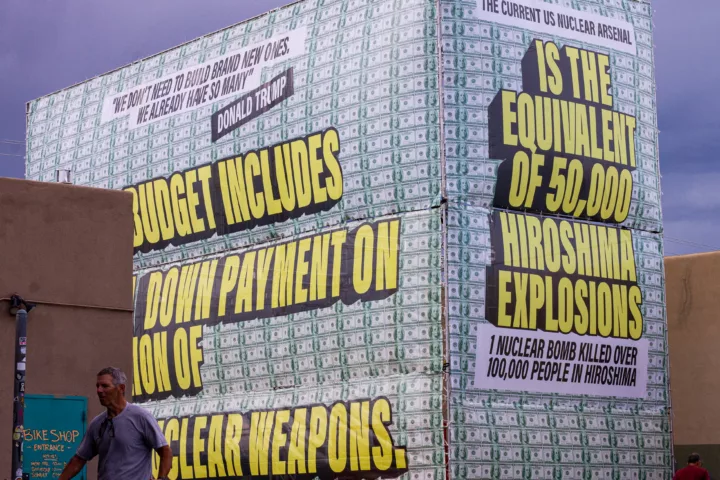The U.S. nuclear strategy of deterrence “aims to prevent an adversary from launching a nuclear weapon by assuring that any first strike will be followed by a retaliatory second strike, whose effects will equal or exceed the original damage and may eliminate the adversary altogether.” From a purely theoretical standpoint, its premise is simple: the threat of overwhelming retaliation should prevent adversaries from launching a first attack. As illuminated in an insightful analysis in the Boston Review, current deterrence policies use perpetual threats of annihilation as a means of coercion. Our most “successful” solution so far to the threat of catastrophic nuclear war has been a tool of extortion, rather than genuine security measures such as binding arms control and nonproliferation agreements.
Deterrance is “framed wholly as defensive and preventative (and from day to day, largely successful in deflecting our attention from the actual first use stance the country has had for nearly eighty years).” [Boston Review] But what if this strategy fails? What if deterrence doesn’t work as intended?
The policy of deterrence assumes that rational actors will always act in their own self-interest to avoid nuclear war.
However, miscalculations, miscommunications, rogue actors and worse do exist. A single false alarm or a misinterpreted military exercise could trigger a nuclear response with irreversible consequences. Beyond this, “human error, a computer failure, or perhaps a cyberattack launched by a terrorist group all could lead to the unintended launch of nuclear weapons.” The world came dangerously close to such scenarios during events like the Cuban Missile Crisis and more recently with heightened tensions between nuclear-armed states. The world has come perilously close to such scenarios, most notably during the Cuban Missile Crisis in 1962, but also more recently with heightened tensions between nuclear-armed states which have escalated at various points, raising fears of potential miscalculations. These kinds of standoffs highlight how fragile and volatile the doctrine of nuclear deterrence is when global stakes are this high.
Ira Helfand, co-founder of Physicians for Social Responsibility, has long argued that the doctrine of deterrence dangerously overestimates the control nations can exert over nuclear escalation, and highlights the precariousness of assuming that deterrence can indefinitely prevent nuclear catastrophe. His work emphasizes that the humanitarian and environmental consequences of even a limited nuclear exchange would be catastrophic, demonstrating that even a “limited” nuclear exchange could trigger widespread destruction, famine, and climate consequences that would affect millions of lives globally.
The UN’s Renewed Focus on Nuclear Risks
In a promising development, the United Nations recently announced plans to conduct a comprehensive study on the broad impacts of nuclear war. This initiative, spurred by increasing geopolitical tensions and nuclear posturing, aims to reframe the conversation on nuclear risks beyond mere strategic calculations to include the devastating social, environmental, and economic consequences. By doing so, it seeks to bring much-needed global attention to the humanitarian imperative of nuclear disarmament.
This shift in focus is crucial as experts like Helfand have pointed out that the catastrophic effects of nuclear conflict are often underestimated in policy discussions. Studies have shown that even a regional nuclear war could disrupt global agriculture, potentially leading to a “nuclear winter” scenario that could starve billions. The UN study could be instrumental in highlighting these dangers and urging nations to rethink the dangerous calculus of deterrence.
Moving Beyond Deterrence
As the world grapples with emerging security challenges—cyber threats and AI, climate change, new forms of warfare—the limitations of nuclear deterrence become even more apparent. The current policy framework not only fails to address these modern threats but also keeps the world perpetually on the brink of disaster.
It is past time for the U.S. and other nuclear powers to adopt a new approach rooted in diplomacy, arms control, and disarmament. The recent UN study could be the catalyst needed to bring about this shift. However, dismantling the entrenched belief in nuclear deterrence requires not just policy changes but also a fundamental rethinking of what true national security means in the 21st century.
We are now at a point where we have to question not whether deterrence can work indefinitely, but rather: What happens if it doesn’t? As history has shown, a single misstep could plunge the world into a nuclear nightmare. The time to rethink nuclear policy and move toward disarmament is now—deterrence is an illusion, not a guarantee of peace.


